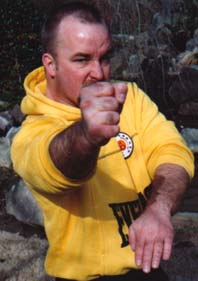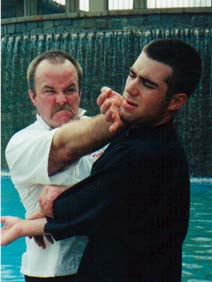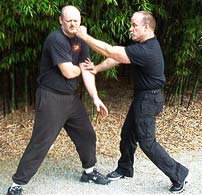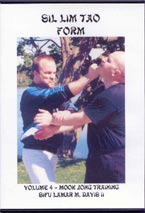
 |

FREQUENTLY ASKED QUESTIONS
A: Wing Chun Gung Fu is the system of martial art that Jeet Kune Do's founder learned in Hong Kong. He trained from age thirteen to age eighteen
in this system and was fortunate enough to be able to train
with Grandmaster Yip Man and two of his most dedicated students,
Wong Shun Leung and Chung Chuk Hing (William Cheung). Wing Chun
Gung Fu basically forms the foundation of Jeet Kune Do!
There are those who train in Jeet Kune Do and Jeet Kune Do concepts
today who claim that Wing Chun is not that important to our structure! Those
practitioners don't know what they are talking about! Although we do not embrace
the entire system, there are many elements of Wing Chun Gung Fu that are practiced
exactly as they are in pure Wing Chun! In fact, it is my belief that Wing Chun
forms the nucleus of Jeet Kune Do, and without it, the Jeet Kune Do practitioner can never reach his or her fullest potential! Only with
a base such as Wing Chun Gung Fu can one develop such a simple, direct,
effective, streetwise, economical system of self defense such as Jeet Kune Do!
Important elements of Wing Chun Gung Fu that are in our training are the centerline
theory, theory of facing, economy of motion theory, the sil lim tao form, vertical
fist punching, the bil jee, low line kicking, defensive positions and lin sil
die dar. Also, one of the most important elements of Jeet Kune Do is
trapping hands. The energy/sensitivity drills, simple and compound reference
point trapping drills and mook jong (wooden man dummy) drills necessary to
develop effective trapping skills all come from Wing Chun Gung Fu!
It is my personal belief that no Jeet Kune Do training program is complete
without a healthy dose of Wing Chun training. My personal experience has shown
that those Jeet Kune Do instructors who don't think that Wing Chun
is that important are either too lazy to get out there and learn some Wing
Chun or they are too impatient and not willing to dedicate the time to it!
Sifu Patrick Strong, who trained with Jeet Kune Do's Founder for six years, and now continues
to train in Wing Chun under Sifu Hawkins Cheung (one of the Founter's Wing Chun
classmates and a close friend), told me that JKD's Founder practiced the sil lim
tao form five to eight times every day! This proves how important the Wing
Chun structure is to Jeet Kune Do! Anyone who says it is not is simply
ignorant, lazy or mis-informed! The Hardcore Jeet Kune Do program emphasizes
a healthy amount of Wing Chun Gung Fu training to develop a strong foundation
structure in all Instructors! We look at it like this: Trying to develop your
skills in Hardcore Jeet Kune Do without having the Wing Chun base is like trying
to build a building of concrete and steel on a styrofoam base, it just doesn't
work! Below is a listing of some of the important elements from Wing Chun Gung
Fu that are in our program.
 · Centerline Theory
· Centerline Theory
·
The Sil Lim Tao Form (Wing Chun's First Form)
·
Four Corner Theory
·
Theory of Facing
·
Immovable Elbow Theory
·
Economy of Movement Theory
·
Defensive Movements
·
Neutral Stance (Training Stance)
·
Lin Sil Die Dar (Simultaneous Defense & Attack)
·
Chung Chuie (Vertical Fist Straight Punch)
·
Bil Jee (Finger Jab)
·
Rotation Striking
·
Jik Chung Chuie (The Straight Blast)
·
Low Line Kicking
·
Don Chi Sao (Single Arm Sticking Hands)
·
Seong Chi Sao (Double Arm Sticking Hands)
·
Cross Arm Chi Sao
·
Phon Sao (Trapping Hands)
·
Mook Jong Training (The Wooden Dummy)
·
Wall Bag Training
·
Rattan Ring Training
Q: Why do some Jeet Kune Do instructors say that trapping doesn’t work?
A: I find that they usually haven’t put in enough work on
the necessary elements to have good trapping hand skills. Those
elements are:
(1) Reference Point Trapping Drills
(2) Energy/Sensitivity Training
(3) Mook Jong Training
Without all three of these very important elements, the Jeet
Kune Do practitioner will never become as good as they can possibly
be! By com-bining these elements with a fair amount of healthy
sparring and application drills, the possibility for high level
trapping ability exists.
Q: What is the difference between Modified Gung Fu and Jeet Kune Do?
A: Modified Gung Fu is the system that JKD's Founder taught when he
first came to the United States. It is basically a modified form
of Wing Chun Gung Fu. This is the art that he taught in
Seattle and the early part of the Oakland period. When an encounter
with a Chinese martial artist named Wong Jak Man in Oakland didn’t
go as well as Bruce would have liked, he felt the need to change
his approach to teaching, training and fighting. This was the birth
of Jeet Kune Do, “The Way of The Intercepting Fist.” Jeet
Kune Do was fully developed during the L. A. Chinatown period.
Jeet Kune Do is based on three things. They are:
(1) Simplicity
(2) Directness
(3) Non-Classical Attitude
 Q: What is “Jeet Kune Do concepts”?
Q: What is “Jeet Kune Do concepts”?
A: This is an approach to training that was developed by Daniel Inosanto after the death of JKD's Founder. The JKD concepts practitioner uses JKD methods to explore and add elements from other martial arts to their training process. Some of them have a strong base in Jeet Kune Do and some do not!
Q: Are we opposed to the Jeet Kune Do concepts approach to training?
A: Not necessarily opposed, we have just chosen a different path! If someone wants to train in the JKD concepts method, and that is what they feel suits them best, more power to them! Just because we do not exactly agree with what they are doing that does not make them our enemy! We are all a part of the JKD family!
 Q: Didn’t JKD's Founder explore other martial arts?
Q: Didn’t JKD's Founder explore other martial arts?
A: Yes, he did, but his approach was not based on adding that art to his system of fighting. He examined other arts so that he would know their strengths and weaknesses. In this way he could better prepare JKD to deal with practi-tioners of these arts if a conflict ever arose!
Q: Is Hardcore Jeet Kune Do strictly a self defense art?
A: Yes! That is why it has often been referred to as “scientific streetfighting”. It is pure and simple self defense for the streets, based on sound scientific principles. There is no sport or tournament application!
Q: Is Hardcore Jeet Kune Do a good art for females to learn?
A: Yes! Because of it’s structure and it’s practical nature, it is perfect for women! After all, the three primary targets are the eyes, throat and groin! These targets do not require strength, only good technique and accuracy!
Q: Can we tell others about the JFFAA?
A: Of course you can, but remember that membership is limited to those who wish to one day become instructors of Hardcore Jeet Kune Do, and have a serious attitude about learning and training! Also, you must be aware of the fact that sometimes others are easily offended if they are already involved in another martial art. Do not present the “our art is better” or “our approach to training is better than yours” attitude. This is a definite turnoff to most! Allow your level of skill to speak for itself!
Q: How soon can a member actually start teaching after joining the JFFAA?
A: As soon as you qualify for teaching the basic beginning level material as outlined in the JFFAA curriculum you may organize a study group and begin having training sessions. To actually be certified as an Apprentice Instructor Level I, you must meet all requirements on that level of the curriculum.
 Q: What are the requirements for becoming a certified Apprentice
Instructor?
Q: What are the requirements for becoming a certified Apprentice
Instructor?
A: The requirements are clearly outlined in the JFFAA curriculum. The Apprentice Instructor Level I test involves several elements from may parts of the curriculum, and represents the minimum knowledge that you need to have in order to start teaching Hardcore Jeet Kune Do to others. Once those requirements have been met satisfactorily and you have passed the test, you will be certified as an Apprentice Instructor Level I.
Q: How long does it take to reach Full Instructor Level?
A: On the average, if an Apprentice works really hard, they should be able to achieve Full Instructorship after about five to seven years of steady training. This could be accomplished faster if someone really works hard, but five to seven years is about average.
Q: There are some pretty strict requirements for Apprentice Instructors. What if, due to financial reasons or unforeseen occurrences, the Apprentice is unable to meet some of the requirements?
A: There are special exceptions for everything! If there is a problem that keeps an Apprentice Instructor from attending a training camp or sponsoring a seminar, I will work with them on this and help them through it! Although these requirements are meant to be upheld and maintained, I understand that sometimes things happen in life that are beyond our control!
Copyright © 2005 Lamar M. Davis
II. All Rights Reserved.
A Webspace Enterprises, Inc. Creation™

